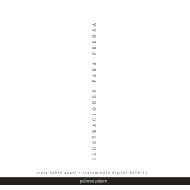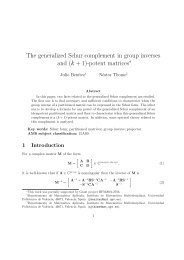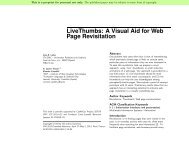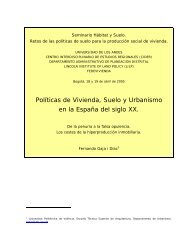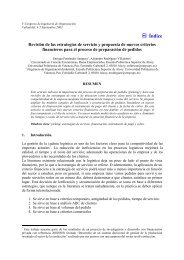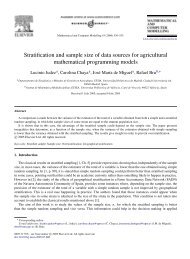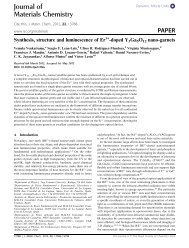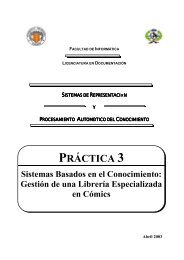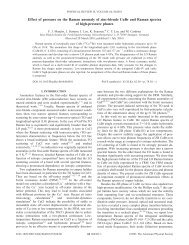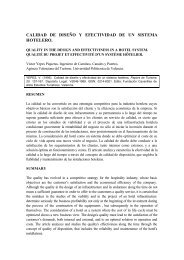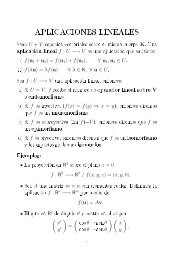Author's personal copy3404 S. Blanes, E. Ponsoda / Journal of Computational and Applied Mathematics 236 (2012) 3394–3408Fig. 1. Error E [1] (t) = ∥H ex (t) − H [1] (t)∥ along the interval t ∈ [0, 1] <strong>for</strong> the choice c(t) = b e at and <strong>for</strong> different values of the parameters a and b.following we analyze the case: c = b e at <strong>for</strong> b ≥ 1, a > 0. In Fig. 1 we show the error E [1] (t) we take ∥A∥ = 1/2i,j A2 i,jalong the interval t ∈ [0, 1] <strong>for</strong> different values of the parameters a and b.Notice that, since c(t) ≥ 1 we can take a norm such that ∥K(t)∥ = c(t) and <strong>for</strong> a small value of a we have thatt∥K(tt 1 0)∥ dt 1 ∼ b, and we still have accurate results <strong>for</strong> b > π where the (sufficient but not necessary) convergencecondition (20) is not satisfied. We can also observe that the accuracy increases <strong>for</strong> small values of a, i.e. when c(t) is close toa constant (in this limit, the ME converges to the exact solution). Similar results are obtained taking <strong>for</strong> c(t) other smoothfunctions.Example 4. In [41] a problem of air pollutant emissions from two regions is proposedx ′ (t) = −ax(t) + bu 1 (t) + bu 2 (t); x(0) = x 0 . (36)Here x(t) is the excess of the pollutant in the atmosphere, u i (t), i = 1, 2, denotes the emissions of each region and a, b arepositive constants related with the intervention of the nature on environment. The cost functions to minimize are given byJ i = 1 2 T0e −ρt c i u 2 i (t) + d ix 2 (t) dt, i = 1, 2, (37)where c i , d i , are positive parameters related to the costs of emission and pollution withstand respectively, and ρ is a refreshrate. With an appropriate change of constants, the problem (36) and (37) can be applied to other situations, such as financialproblems <strong>for</strong> example, see [4].In our notation, Q iT = 0, i = 1, 2, R ij = 0, i ≠ j, Q i (t) = d i e −ρt , R ii = c i e −ρt , and S i = b 2 e ρt /c i , i = 1, 2.We generalize this problem to the case of N regions (N players) where the Eq. (36) changes tox ′ (t) = −ax(t) + bNu i (t); x(0) = x 0 ,i=1and the index <strong>for</strong> the remaining parameters range <strong>for</strong> i = 1, . . . , N. Then, following the steps indicated at the end ofSection 2.1, we have:• the Eq. (15) with the datay ′ (t) = K(t)y(t), y(T) = [1, 0, . . . , 0] T ;
Author's personal copyS. Blanes, E. Ponsoda / Journal of Computational and Applied Mathematics 236 (2012) 3394–3408 3405Fig. 2. Error ∥y(0) − y ap (0)∥ versus the number of evaluations of the matrix K(t) (twice the number of steps) in <strong>solving</strong> the Riccati equation (38) using:the standard fourth-order Runge–Kutta method (circles joined by lines), the commutator-free fourth-order exponential method (stars joined by lines), andthe second order exponential method (squares joined by lines).⎡ ⎤u(t)v 1 (t)y(t) = ⎢⎥⎣. ⎦ ;v N (t)⎡⎤−a − b2e ρt · · · − b2e ρtc 1 c N K(t) = −d 1 e −ρt a · · · 0, (38)⎢⎣... ... ..⎥⎦−d N e −ρt 0 · · · athat must be solved from t = T to t = 0.• With u(t) and v i (t) obtained in the previous step, we evaluatep i (t) = v i(t), i = 1, . . . , N,u(t)when u(t) ≠ 0.• Solve the transition equationNφ ′ (t) = −a − b 2 e ρt 1p i (t) φ(t), φ(0) = 1, (39)c ii=1and calculate the dynamic state of the game: x(t) = φ(t) x 0 .• Finally, we can determine the controlsu i (t) = − 1 c ie ρt b p i (t) φ(t) x 0 , i = 1, . . . , N.In our numerical experiments we take T = 1 and consider the case of N = 10 players, and the parameters used are:c i = i/2, d i = 2/i, i = 1, . . . , 10, b = 3/2, and we take different values <strong>for</strong> a and ρ.As a standard numerical method we take the well known 4-stage fourth-order Runge–Kutta method. For the <strong>linear</strong> nonautonomousproblem (17), this method requires only two evaluations of the matrix K(t), and in this sense it is optimal.



